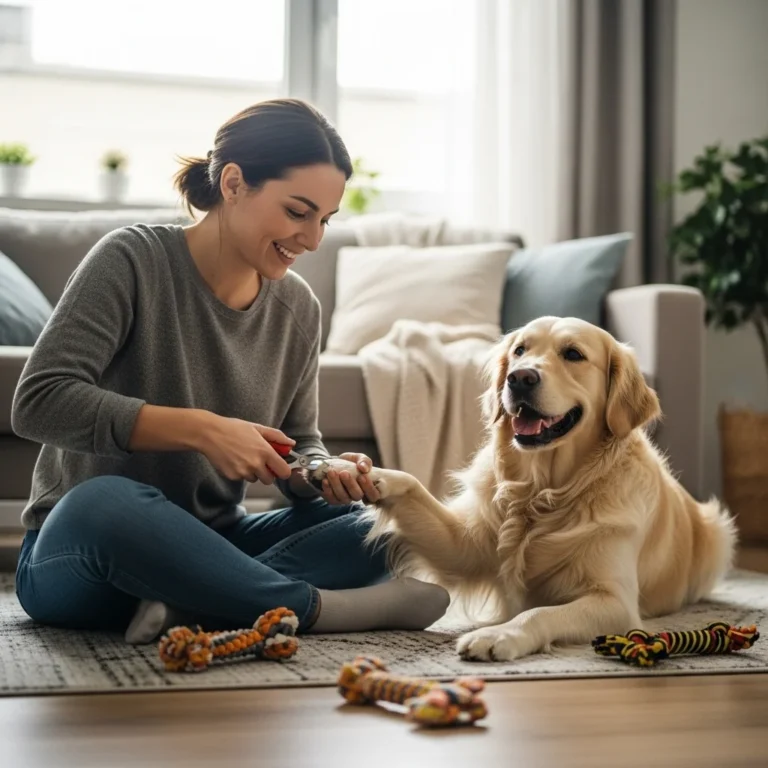
🐶💖 how to trim dog nails 🐶💖
Hi there, fellow dog lover! Have you ever looked at your pup’s paws, heard that telltale click-click on the tile, and thought, “Oh no, it’s nail time again”? Don’t worry—you’re in great company. Nail trimming is one of those tasks most of us put off, not because we don’t care, but because it can be nerve-wracking.
The good news? Once you know how often to trim dog nails safely, how often to trim dog nails(and a few tricks from the pros), it stops feeling like a chore and starts becoming a relaxing bonding moment with your furry best friend. So, grab your treats, a comfy spot, and let’s walk through this together—paw by paw.
Understanding the Basics of Dog Nail Trimming
Why is it important to trim your dog’s nails?
Your dog’s nails aren’t just for scratching or digging—they’re a huge part of their comfort and posture. According to VCA Animal Hospitals, overly long nails can change how your dog walks, putting pressure on their toes and even affecting their spine alignment. That’s why regular trims are more than cosmetic; they’re essential for mobility and joint health.
When your dog’s nails are the right length, they move naturally, comfortably, and confidently. It’s one of those small habits that make a big difference.(source)
What happens if you don’t trim your dog’s nails regularly?
Skip a few nail sessions, and you’ll start hearing that clicking sound. Left too long, nails can curl under and press into the paw pads—ouch! Over time, this pressure can cause your dog to limp, avoid walks, or even develop joint pain. Rossmore Veterinary Hospital warns that neglected nails can shift your dog’s stance, causing strain and soreness that’s easily avoidable with regular care.
How often should you trim your dog’s nails?
Most vets and groomers recommend trimming every 3–4 weeks, though it varies. Dogs that walk frequently on concrete or rough terrain may naturally file down their nails and need fewer trims. West Concord Animal Clinic notes that the best rule of thumb is to check the nails regularly instead of relying strictly on a calendar.(source)
How can you tell when your dog’s nails are too long?
You’ll know it’s time when:
- You hear nails clicking on hard floors.
- The nails touch the ground when your dog stands.
- You notice a curve or pressure into the paw pad.
If any of these apply, it’s trimming time!(source)
Is nail trimming painful for dogs?
Not if done correctly. The “quick”—a sensitive blood vessel inside the nail—is what you want to avoid. If you stay ahead of it, trimming is completely pain-free. West Concord Animal Clinic explains that careful trimming with proper tools makes it a breeze, even for dark nails (we’ll cover that later).
Getting Prepared: Tools and Setup
What are the best tools for trimming dog nails (clippers vs. grinders)?
There are two main tools: clippers and grinders.
According to The Dink Dog Mom, clippers work faster and are great for a first pass, while grinders are slower but give smoother, safer finishes. Clippers come in scissor-style (great for control) and guillotine-style (quick and efficient).(source)
Grinders—like the Dremel type—use gentle filing to shape nails. They’re awesome for nervous pups who dislike the pressure of clipping.
Which clipper type is best for small or large dogs?
For tiny paws and fine nails, go for scissor-style clippers—they’re easier to control. For bigger dogs, RescueDogs.co.uk recommends heavy-duty scissor clippers with wider blades for clean cuts and less resistance.(source)
What additional supplies do you need?
Here’s your go-to trimming kit:
- Styptic powder – to stop bleeding if you nick the quick (PetMD-approved).
- Towel or non-slip mat – for stability.
- Treats – for bribes… er, positive reinforcement!
- Nail file or grinder – to smooth out rough edges.
- Good lighting – helps you see where to cut.
Having everything ready keeps you calm—and your dog will feel that energy, too.
Should you bathe your dog before trimming?
Not mandatory, but helpful! A warm bath can soften nails and make trimming easier. Just be sure the paws are dry before cutting; wet nails can slip. This step is more about comfort than necessity.
How can you get your dog comfortable before starting?
This is where patience pays off. VCA Animal Hospitals recommends gradual paw handling to reduce fear. Let your dog sniff the tools, touch their paws gently, and reward them with treats. Start small—maybe one nail per day until they relax.
When trimming feels routine instead of scary, your dog’s anxiety drops dramatically.
Step-by-Step Guide: How to Trim Your Dog’s Nails Safely
How do you properly hold your dog’s paw?
Sit beside your dog, not above. Gently lift one paw and support the pad with your thumb underneath. Use your other hand to hold the clipper or grinder. Keep things calm—soft voice, slow movements. If your dog pulls away, pause, praise, and try again later.
What is the correct angle for cutting?
Trim at a 45-degree angle, slightly away from the quick. The idea is to mimic the natural curve of the nail without digging into the sensitive part. Rossmore Veterinary Hospital suggests cutting just above where the nail starts to curve.
How much of the nail should you cut?
Less is more. Take tiny snips—especially for dark nails. You can always trim more later. For light nails, stop just before the pink quick.
How can you identify and avoid the quick?
For clear nails, the quick is the pink center—don’t cut into it. For dark nails, watch for a gray or white circle in the middle as you cut—that’s your signal to stop. Dr. Chuck Books emphasizes trimming a bit at a time to stay safe.
how to trim black dog nails?
Go slowly. Clip small bits and check often. You can also shine a flashlight under the nail to help spot the quick. Some owners even use a “spaghetti trick” shared on Reddit—pretend to clip dry spaghetti near your dog’s paw, reward with treats, and repeat until your dog’s chill.
What’s the difference between clipping and grinding?
Clipping is quick and efficient, while grinding gives you control and smoother results. The Dink Dog Mom suggests combining both: clip for length, grind for finish.
How do you trim dewclaws properly?
Those little side nails don’t touch the ground, so they grow faster. Hold the paw steady and trim just the tip. Because they’re easy to overlook, check dewclaws every session!
Handling Fearful or Restless Dogs
What can you do if your dog hates nail trimming?
You’re not alone! Many dogs dislike it because paws are sensitive. Trainer Lori Nanan, creator of Nailed It: A Canine Course In Nail Care, says that helping a dog feel relaxed takes “patience, repetition, and empathy.”
Start small: touch the paw, treat, release. Gradually add more steps over time.(source)
How do you desensitize a nervous dog?
According to VCA Animal Hospitals, the trick is exposure and reward:
- Touch and hold the paw.
- Let your dog inspect the tool.
- Make the trimming sound (without cutting).(source)
- Reward after every calm step.
When your dog associates the process with fun and treats, stress levels drop.
How can you make it a positive experience?
Turn trimming into a game! Try a lick mat (as shared by a Reddit user) with peanut butter. Stick it on a wall and trim while your dog licks away happily. Add calm music, praise, and a few “good boy/girl!” cheers—it helps more than you’d think.
What about trimming a wiggly puppy?
Keep it short and sweet. One or two nails per session, lots of praise, and finish on a good note. Use a non-slip mat and make it feel like playtime. Before long, it’ll be no big deal.
Troubleshooting and Dealing With Mistakes
What should you do if you cut the quick?
Don’t panic! It happens. Apply gentle pressure with a clean cloth, then use styptic powder (PetMD recommends this) or cornstarch to stop bleeding. Comfort your dog, give a treat, and take a break before trying again.
How do you stop bleeding safely?
Hold pressure for about a minute. Once bleeding stops, clean the area gently. Avoid alcohol or strong antiseptics, which can sting.
How can you prevent infection or soreness?
File sharp edges, keep paws clean, and avoid long outdoor walks immediately afterward. If you notice swelling, redness, or limping, contact your vet.
When should you call a vet or groomer?
If your dog’s nails are severely overgrown, infected, or if they show extreme fear or aggression, let a professional groomer or vet handle it. They have the right tools and training for tough cases.
Adapting for Different Dogs and Needs
How does nail trimming differ for puppies, seniors, or specific breeds?
- Puppies: Softer nails, so trim more often but lightly. Make it fun!
- Seniors: Use padded surfaces for comfort. Trim slower; joints may ache.
- Breeds: Larger breeds = thicker nails. Some breeds also have extra dewclaws—check them regularly.
What should you consider for dogs with health issues?
If your pup has arthritis or hip dysplasia, trimming can be harder. Try trimming when they’re most relaxed—after a nap or short walk. Support the paw gently, and go slow.
How do you help the quick recede?
Frequent, light trims encourage the quick to pull back naturally. Combine that with walks on pavement, and over time, your dog’s nails will reach a healthy length again.
Alternatives and Maintenance Tips
Is a grinder safer than clippers?
Grinders can be gentler since you file gradually instead of cutting sharply. Many dogs find them less scary when introduced slowly. The Dink Dog Mom notes that clippers are best for length, grinders for smoothing.
Can regular walks on pavement help?
Yes! Hard surfaces naturally file nails. But if your dog spends most time indoors or on grass, trimming is still necessary.
How can you maintain nail length between trims?
- Walks on rough surfaces.
- Weekly “paw checks.”
- Keep your trimming tools in one spot for consistency.
- Reward your dog every time—it keeps the process positive.
For more everyday grooming advice, check out DogsBlogs.com – Daily Grooming Basics for Dogs.
And if you’re building a home routine, don’t miss DogsBlogs.com – Best Practices for Home Dog Care.
Are there alternatives to traditional trimming?
Some owners use dog-specific nail files or buffing tools. Others rely on professional groomers for monthly trims. The goal is the same—keeping nails short, clean, and healthy.
How do you keep track of trims?
Use a grooming calendar, or set reminders in your phone. You can even take “paw pics” to monitor growth over time. Consistency keeps you one step ahead of overgrowth.
Conclusion
Trimming your dog’s nails doesn’t have to be stressful—it can be part of your love language. Each gentle clip or grind is a small act of care that helps your dog move freely and feel great.
Take it slow, stay calm, and remember: practice makes perfect. Soon enough, how to trim a dog’s nails will feel like second nature—and those quiet, click-free steps on the floor? Totally worth it.
Here’s to happy paws, peaceful trims, and a stronger bond with your best friend.
please leave comment
you may like it






